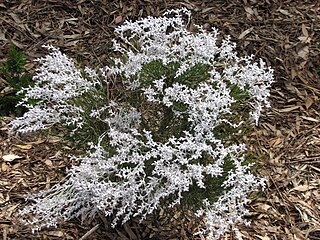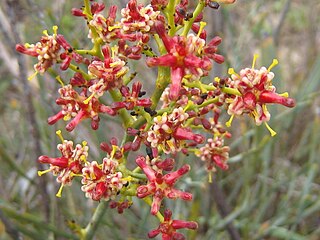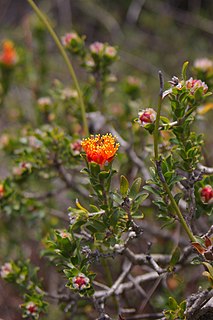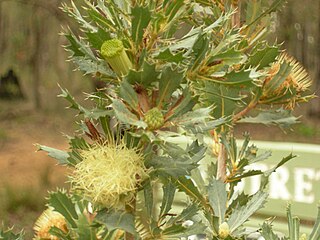
Banksia nobilis, commonly known as the golden dryandra, great dryandra or kerosene bush, is a shrub of the family Proteaceae which is endemic to Western Australia. It occurs on lateritic rises from Eneabba to Katanning in the state's Southwest Botanic Province. With large pinnatifid leaves with triangular lobes, and a golden or reddish pink inflorescence, it is a popular garden plant. It was known as Dryandra nobilis until 2007, when all Dryandra species were transferred to Banksia by Austin Mast and Kevin Thiele. There are two subspecies, B. nobilis subsp. nobilis and B. nobilis subsp. fragrans.

Banksia proteoides, commonly known as king dryandra, is a shrub endemic to Western Australia. It was known as Dryandra proteoides until 2007, when all Dryandra species were transferred to Banksia by Austin Mast and Kevin Thiele.
Conospermum acerosum, commonly known as needle-leaved smokebush, is a shrub endemic to Western Australia
Conospermum glumaceum, commonly known as hooded smokebush, is a shrub endemic to Western Australia.

Conospermum stoechadis, commonly known as common smokebush, is a shrub endemic to Western Australia.
Conospermum stoechadis subsp. sclerophyllum is a shrub endemic to Western Australia.

Conospermum incurvum, commonly known as plume smokebush, is a shrub endemic to Western Australia.

Stirlingia, commonly known as blueboy, is a genus of 7 species in the family Proteaceae, all of which are endemic to Western Australia.

Stirlingia latifolia, commonly known as blueboy, is a plant endemic to Western Australia.

Eremaea is a genus of woody shrubs and small trees in the family Myrtaceae and is endemic to the south-west of Western Australia. Little study of the genus as a whole had been undertaken until Roger Hnatiuk researched Eremaea and published a paper in 1993, A revision of the genus Eremaea (Myrtaceae) in Nuytsia. The first species to be described was Eremaea pauciflora in 1837 and by 1964, the number of species known had increased to 12. Hnatiuk recognised 16 species, 5 subspecies and a number of varieties.

Banksia sessilis var. cordata is a variety of Banksia sessilis, with unusually large leaves and flower heads. It is a rare variety that is restricted to the extreme south-west corner of Western Australia.

Banksia sessilis var. sessilis is the most populous and most widespread variety of Banksia sessilis.
Banksia sessilis var. flabellifolia is a variety of Banksia sessilis.

Lambertia inermis, Noongar chittick, is a shrub which is endemic to south-west Western Australia. It grows to 6 metres high and flowers from spring to winter. A more complete description is given in Florabase and Australian Flora online.

Amyema quandang is a species of hemi-parasitic shrub which is widespread throughout the mainland of Australia, especially arid inland regions, sometimes referred to as the grey mistletoe.

Adenanthos barbiger, the hairy jugflower or hairy glandflower, is a species of shrub in the family Proteaceae. It is endemic to the south-west of Western Australia. It usually grows to 1 metre high, and has bright red flowers that appear mostly between August and December. The species was first formally described in 1839 by English botanist John Lindley in A sketch of the vegetation of the Swan River colony.

Eremaea pauciflora is a plant in the myrtle family, Myrtaceae and is endemic to the south-west of Western Australia. It is a shrub with small leaves and orange flowers at the ends of its branches. It has the most widespread distribution of the eremaeas with considerable variation in its characteristics so that three varieties are recognised. It was the first Eremaea to be described formally but was not originally given the name Eremaea.

Lambertia orbifolia, commonly known as the roundleaf honeysuckle, is a shrub or small tree that is endemic to the south-west of Western Australia. It has more or less circular leaves and groups of between four and six orange-red flowers.

Verticordia densiflora, commonly known as compacted featherflower, is a flowering plant in the myrtle family, Myrtaceae and is endemic to the south-west of Western Australia. It is a shrub with small leaves, usually small pink and white flowers and which is widespread in the south-west of the state. It is a variable species and in his 1991 paper, Alex George formally described five varieties.

Trymalium ledifolium, sometimes called Star Buckthorn, is a plant species in the Rhamnaceae family, found in the south-west of Western Australia. It is a shrub which grows from 0.3 to 2.5 m high, and grows on clay, gravel, loam and sand, on granite, limestone and laterite and on outcrops and dunes. Flowering from June to November, the flowers are a white-cream.















